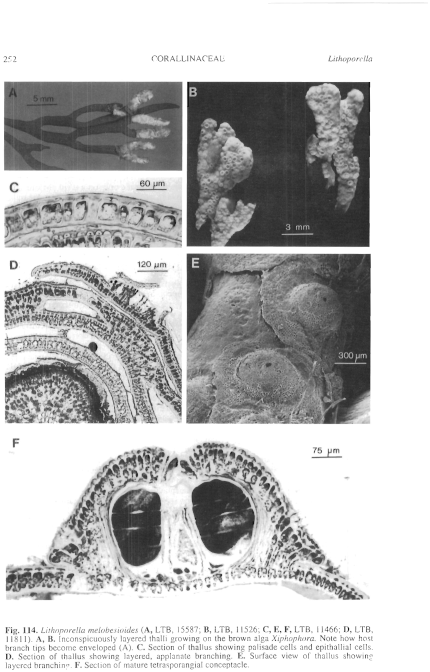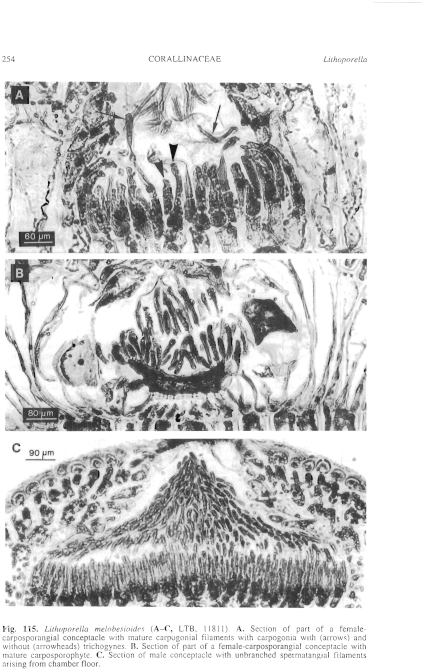|
|
|
|
|
|||||||||||
|
Electronic Flora of South Australia Species Fact Sheet
Phylum Rhodophyta – Class Florideophyceae – Order Corallinales – Family Corallinaceae – Subfamily Mastophoroideae
Selected citations: Adey et al. 1982: 34, fig. 20. Gordon et al. 1976: 257, pl. IV figs 4, 5, pl. V fig. 1. John et al. 1994: 66. Lemoine 1970a: 2645, pl. 1 figs 1–5; 1974: 32, pls 4–6; 1976: 773, pls 1, 2. Masaki 1968: 55, pl. 38, pl. 79 figs 1–5. Nelson & Adams 984: 18. Tseng 1983: 78, pl. 42 fig. 4. Turner & Woelkerling 1982a: 204, figs 2–4, 9, 10, 12, 13, 16–25, 29, 30, 36; 1982b: 219, figs 2, 4, 6–11, 15–17, 20–22, 25–27. Womersley & Bailey 1970: 310. Zhang & Zhou 1980: 72, pl. II figs 1–3.
Synonyms
Mastophora melobesioides Foslie 1903a: 24; 1904a: 74, figs 30–32. Woelkerling 1993: 148.
Melobesia melobesioides (Foslie) Lemoine 1927: 196; 1939: 108, fig. 79.
Litholepis melobesioides (Foslie) Weber-van Bosse 1932: 21.
Thallus normally pinkish, encrusting to foliose, mostly 4–15 mm across, epigenous and affixed by localised cell adhesion or envelopment of host axes; lamellate branches common, applanate and often forming a number of layers that may or may not be conspicuous. Structure pseudoparenchymatous with dorsiventral organisation throughout; construction dimerous, each branch consisting of a single ventral layer of branched, laterally cohering, filaments each usually composed of palisade cells 10–35 (–69) µm long and 25–70 µm high, and additionally of epithallial cells or in areas of branching filaments 2–3 (–5) cells long terminating in epithallial cells and arising perpendicularly from cells of the ventral filaments, cells 10–35 µm in diameter and 14–60 (–80) µm long; epithallial cells (5–) 10–38 µm in diameter and 5–20 µm long with distal walls rounded or flattened but not flared; cells of adjacent filaments joined by cell fusions, secondary pit-connections and haustoria unknown; trichocytes sometimes present, occurring singly or in horizontal rows or fields and occasionally dividing transversely or obliquely to form two cells.
Reproduction: Vegetative reproduction unknown. Gametangia, carposporangia and tetrasporangia produced in uniporate conceptacles, gametangia and carposporangia formed on thalli separate to those bearing tetrasporangia, conceptacles borne only on dorsal thallus surfaces. Bisporangia unknown.
Gametangial thalli dioecious. Carpogonia terminating 2- or 3-celled filaments arising from the female conceptacle chamber floor. Mature female-carposporangial conceptacle roofs protruding above surrounding thallus surface, 50–120 µm thick, composed of 2–4 layers of cells above the chamber, conceptacle chambers 230–555 µm in diameter and 80–300 µm high. Carposporophytes developing within female conceptacles after karyogamy, composed of a conspicuous central fusion cell and several-celled gonimoblast filaments bearing terminal carposporangia 65–150 µm in diameter. Spermatangial filaments unbranched, borne across the male conceptacle chamber floor, mature male conceptacle roofs protruding above surrounding thallus surface, 100–235 µm thick, composed of 3–7 layers of cells above the chamber, male conceptacle chambers 210–315 µm in diameter and 60–90 (–125) µm high.
Tetrasporangial conceptacle roofs protruding above surrounding surface, 70–95 µm thick above the chamber and composed of 2–4 layers of cells, pore canals lined by cells that are orientated more or less perpendicularly to the roof surface and do not protrude into the canal, conceptacle chambers (225–) 260–445 µm in diameter and (160–) 210–270 µm high; tetrasporangia scattered across the conceptacle chamber floor, each mature sporangium 50–90 (–110) µm in diameter and 120–220 µm long, containing zonately arranged spores.
Type from South Nilandu, Maldive Islands; lectotype in TRH (unnumbered), designated by Foslie (1904a: 74), depicted in Foslie (1904a, text figs 30a, 31a), Printz (1929: pl. 73 fig. 1), Turner & Woelkerling (1982a: fig. 2); additional data provided by Woelkerling (1993: 148).
Selected specimens: South West River, Hansen Bay, Kangaroo I., S. Aust., upper sublittoral (Woelkerling, 21.ii.1979; LTB, 11631). Seal Bay, Kangaroo I., S. Aust., upper sublittoral (Woelkerling, 22.ii.1979; LTB, 11787). Cape Willoughby, Kangaroo I., S. Aust., on Xiphophora, sublittoral fringe (Womersley, 25.i.1948; AD, A48115 = LTB, 13753; Woelkerling, 25.ii.1979; LTB, 11565) and 0–2 m deep (Campbell & Penrose, 6.iv.1988; LTB, 15587). Kitty Miller Bay, Phillip I., Vic., 1–2 m deep (Woelkerling, 18.vi.1983; LTB, 13579) and in lower eulittoral tidepools on Xiphophora (Turner, 24.i.1979; LTB, 11466). Cunningham Bay, Phillip I., Vic., in pools (Turner, 15.vi.1979; LTB, 11788 and 29.vii.1979; LTB, 11811). Bear Gully (Maitland Beach), Vic., upper sublittoral (Turner, 24.xii.1978; LTB, 11526 and 30.v.1979; LTB, 11786). Curries River mouth, Tas., lower eulittoral pools (Womersley, 28.i.1949; AD, A10315 = LTB, 13752).
Distribution: Reported from various islands in the tropical Atlantic, Indian and Pacific Oceans (Adey et al. 1982; John et al 1994; Masaki 1968; Womersley & Bailey 1970) and from the Red Sea; China; Japan and the Kermadec Is (New Zealand); most records require confirmation. In southern Australia, South West River, Hansen Bay, Kangaroo I., S. Aust., to Bear Gully (Maitland Beach), Vic., and Curries River, Tasmania.
Taxonomic notes: Lithoporella melobesioides has been found in southern Australia as an epiphyte on the brown alga Xiphophora chondrophylla and on the geniculate coralline algae Corallina and Jania in intertidal tide pools and subtidally at depths of 0.5–2 m. Both gametangial and tetrasporangial thalli occur within single populations. Adey et al. (1982, p. 35) reported the species from the intertidal to depths of 85m in the Hawaiian Is. The type collection (Woelkerling 1993, p. 148) from the Maldive Is and specimens from the Solomon Is (Womersley & Bailey 1970) occur on coral rubble, while Foslie (1904a, p. 73) records collections on a variety of other substrata. Lemoine (1976) provides an account of a number of fossil collections.
References:
ADEY, W.H., TOWNSEND, R.A. & BOYKINS, W.T. (1982). The crustose coralline algae (Rhodophyta: Corallinaceae) of the Hawaiian Islands. Simthson. Contr. Mar. Sci. No. 15, 1–74.
FOSLIE, M. (1903a). Den botaniske samling. K. norske Vidensk. Selsk. Aarsberetn. 1902, 23–25. Note: also issued as an unpaginated offprint with the printing date of 12.ii.1903
FOSLIE, M. (1904a). I. Lithothamnioneae, Melobesieae, Mastophoreae. Siboga- Expeditie 61, 10–77.
FOSLIE, M. (1909). Algologiske notiser. VI. K. norske Vidensk. Selsk. Skr. 1909(2), 1–63.
GORDON, G.D., MASAKI, T. & AKIOKA, H. (1976). Floristic and distributional account of the common crustose coralline algae of Guam. Micronesica 12, 247–277.
JOHN, D.M., LAWSON, G.W., PRICE, J.H., PRUD'HOMME VAN REINE, W.F. & WOELKERLING, W.J. (1994). Seaweeds of the western coast of tropical Africa and adjacent islands: a critical assessment. IV. Rhodophyta (Florideae) 4. Genera L-0. Bull. nat. Hist. Mus. Lond., Bot. Ser. 24, 49–90.
LEMOINE, M.(Mme P.) (1927). Étude des Mélobésiées tertiares d' Algerie. C. r. Ass. Fr. Adv. Sci. 1927, 194–196.
LEMOINE, M.(Mme P.) (1939). Les algues calcaires fossiles de l'Algérie. Matériaux pour la Carte Géologique de l'Algérie, Sér. Paléontologie, 9, 1–131, Plates 1–3.
LEMOINE, M. (1976). Le genre Lithoporella Foslie (algue Rhodophycée Coralinacee) au Tertiaire et an Quaternaire. Bull. Soc. géol. Fr., Ser. 7, 18, 773–787.
MASAKI, T. (1968). Studies on the Melobesioideae of Japan. Mem. Fac. Fish. Hokkaido Univ. 16, 1–80, Plates 1–79.
PRINTZ, H. (1929). M. Foslie — &lsquot;Contributions to a Monograph of the Lithothamnia&rsquot;. K. Norske Vidensk. Selsk. Skr. Museet, Trondhjem. 60 pp. 75 Plates.
TSENG, C.K. (1983). Common Seaweeds of China. (Science Press: Beijing.)
TURNER, J.A. & WOELKERLING, W.J. (1982a). Studies on the Mastophora — Lithoporella complex (Corallinaceae, Rhodophyta). I. Meristems and thallus structure and development. Phycologia 21, 201–217.
TURNER, J.A. & WOELKERLING, W.J. (1982b). Studies on the Mastophora — Lithoporella complex (Corallinaceae, Rhodophyta). II. Reproduction and generic concepts. Phycologia 21, 218–235.
WEBER-VAN BOSSE, A. (1932). Algues. Résult. scient. Voyage Indes orient. néerl. 6(1), 1–27, Plates 1–5.
WOELKERLING, Wm.J. (1993). Type collections of Corallinales (Rhodophyta) in the Foslie Herbarium (TRH). Gunneria 67, 1–289.
WOMERSLEY, H.B.S. & BAILEY, A. (1970). Marine algae of the Solomon Islands. Phil. Trans. R. Soc. Lond. B. Biological Sciences 259, 257–352.
ZHANG, D. & ZHOU, J. (1980). Studies on the Corallinaceae of the Xisha Islands, Guangdong Province, China. II. Studia mar. Sinica 1980(12), 71–74, Plates 1–2.
The Marine Benthic Flora of Southern Australia Part IIIB complete list of references.
Publication:
Womersley, H.B.S. (28 June, 1996)
The Marine Benthic Flora of Southern Australia
Rhodophyta. Part IIIB. Gracilarialse, Rhodymeniales, Corallinales and Bonnemaisoniales
Reproduced with permission from The Marine Benthic Flora of Southern Australia Part IIIB 1996, by H.B.S. Womersley. Australian Biological Resources Study, Canberra. Copyright Commonwealth of Australia.
Illustrations in Womersley Part IIIA, 1996: FIGS 114, 115.

Figure 114 enlarge
Fig. 114. Lithoporella melobesioides (A, LTB, 15587; B, LTB, 11526; C, E, F, LTB, 11466; D, LTB, 11811). A, B. Inconspicuously layered thalli growing on the brown alga Xiphophora. Note how host branch tips become enveloped (A). C. Section of thallus showing palisade cells and epithallia] cells. D. Section of thallus showing layered, applanate branching. E. Surface view of thallus showing layered branching. F. Section of mature tetrasporangial conceptacle.

Figure 115 enlarge
Fig. 115. Lithoporella melobesioides (A–C, LTB, 11811). A. Section of part of a female-carposporangial conceptacle with mature carpogonial filaments with carpogonia with (arrows) and without (arrowheads) trichogynes. B. Section of part of a female-carposporangial conceptacle with mature carposporophyte. C. Section of male conceptacle with unbranched spermatangial filaments arising from chamber floor.

|
Email Contact: State Herbarium of South Australia |

|